In 2014, Elle Magazine announced “Meet the very real woman behind the planet’s most perfect face: It’s Joan Smalls. Supermodels, over? As if. Joan Smalls wields the kind of flawless, unequivocal beauty that is both a throwback to the past and a sign that fashion is finally facing the future.”
The Elle article describes Joan’s background and rise to supermodel status, saying, “The hair is long and straight, the bone structure aquiline, the smile dazzling. No wonder Smalls is kicking up the kind of fashion-industry excitement that comes along only a handful of times each decade. Over the past year, she has snagged the number-one spot on Models.com, having pulled in a rumored $3.5 million—making her the eighth-highest-paid model in the world, according to Forbes.” (Follow her on Facebook, Instagram and Twitter.)
Is “flawless, unequivocal beauty” marketing hype or mathematical fact?
LA Times reporter Rene Lynch was intrigued, but wanted to do some investigative reporting on this claim of “flawless, unequivocal beauty.” Was it just hype? Could it be substantiated? She called on the Phi Guy, Gary Meisner, author of Phi: The Golden Number and developer of PhiMatrix golden ratio design and analysis software to see what some golden ratio analysis would reveal. Gary invited Dr. Stephen Marquardt, inventor of the Marquardt Beauty Mask to collaborate on the analysis.
Rene’s full article with our interview appeared as a front page feature story on beauty in the LA Times as “Puerto Rican model has ‘planet’s most perfect face’? We find out.” Below are some of the results of the facial analysis performed by Dr. Marquardt and I using our respective golden ratio based tools.
Facial beauty analysis based on the Golden Ratio
I analyzed Joan’s face with PhiMatrix software to determine the presence of the golden ratio, the classic marker of beauty, in the proportions of her facial features. Click on any image for the full size image.
- Joan Smalls
- Horizontal Golden Ratios
- Vertical Golden Ratios
On the horizontal measures, the golden ratios found were not surprising for a beautiful supermodel:
- the inside points of her eyes to the width of her face (gold lines)
- the outside points of her eyes to the distance from the center of her nose to the width of her face (white lines)
- the points of her upper lips (cupid’s bow) to the width of her mouth (green lines)
- the width of her nose to the half-width of her mouth (red lines)
- the width of her lateral incisor tooth to the width of her central incisor tooth (blue lines)
The vertical measures were a bit more surprising and atypical. Golden ratios were found at:
- the height of the eyes to the distance from the bottom of the eyes to the top of the eyebrows (gold lines)
- the flare of the nose to the distance from the pupils to the tip of the nose (aqua lines)
The surprising measures were those that showed her face to be relatively long:
- the bottom of the teeth were at a lower point than is often found in the distance from the pupils to the bottom of the chin (green lines)
- the hair line was a higher point than is often found in the distance from the bottom of the eyes to the top of the eyebrows to the hairline (white lines)
Facial beauty analysis based on the Marquardt Beauty Mask
Dr. Marquardt’s analysis with his Beauty Mask revealed similar findings. We noted that in performing the facial analysis, we had to stretch the beauty mask to 108% of its normal height to fit her face. With this revision made, many of her facial components (eyes, brows, cheeks, chin and lips) matched the mask to a striking degree. Having to narrow the mask to be able to fit it to her face immediately tells us she’s not a classic beauty. This confirms the results of the golden ratio analysis above, which also revealed that Joan’s face is relatively longer and narrower than that of most women regarded to have classic beauty.
Even after the vertical stretching, a few of the components of her face were still not completely aligned with the mask and our classic golden ratio beauty measures. The left side of her face (on the right side of the photo below) was slightly higher than her right side and her lower jaw is rather narrow at the chin lines.
- Joan Smalls
- Beauty Mask – Original dimensions
- Beauty Mask – Stretched vertically by 108%
Facial symmetry analysis
Symmetry does not necessarily create beauty, but beauty is sometimes augmented by facial symmetry. If Joan has the “planet’s most perfect face” we might expect to see a high degree of symmetry between the left and right half of her face. This, though, does not seem to be the case. The right half of her face appears to be very slightly wider and higher than the left side. The visual effect of this in mirrored photos can sometimes be exaggerated by a slightly off-center angle of the face to the camera, but it still seems to be true of her face.
There’s more to beauty than what meets the eye
So, as demonstrated from the facial analysis, Joan is unquestionably beautiful, but her face has a number of features that do not merit descriptions of unequivocally “perfect” or “flawless.” So why does Elle make such a bold claim? First, there’s the obvious sizzle factor. Claims like this sell more magazines than “here’s another pretty face we found to put on our next magazine cover.”
Another factor is that you have to consider what constitutes “perfection.” I would contend that there’s much more to Joan’s success and fame than the precise measurements of her facial proportions. As shown in the photos at the beginning of the article, she can very successfully adapt her look and expressions to carry off everything from exotic/mysterious to sophisticated, to the smiling, trendy school girl. Not everyone can do that. More yet, the Elle article describes a personal presence that makes those around her sense a very special quality, a confidence or air, even in the way she speaks.
A key point of this is that true beauty is measured by more than the facial proportions that we analyzed in exacting mathematical detail. It appears that Joan’s deviations from mathematical facial perfection are more than offset by many other qualities that come from her inner strength, beauty, expressiveness and style. That is an important point that anyone who is asking “how can I be more beautiful” should duly note. Dr. Marquardt’s general research shows that a smiling face conforms more closely to golden ratio proportions than a reposed (no smile) one. A smiling face is certainly far more beautiful than a face with a look of anger or arrogance. Looks can indeed kill, and the victim is most often your own personal appearance.
Inner qualities, cosmetics, personal style and presentation are all part of beauty
Joan’s inner qualities are also profiled in the Elle article, and readers should not let those qualities be overshadowed by the headline-making claims of the physical perfection of her beauty. Most of their readers cannot change their facial dimensions. They can change makeup, clothing and hairstyles, which all have very real impacts on our perceptions of beauty. They can aspire and learn to change their inner qualities of beauty as well. All these are critical to the beauty of a supermodel, and to everyone else.
Classical beauty versus exotic beauty
After the interview with Rene, Dr. Marquardt and I continued our discussion on non-classical beauty. We both feel that Joan fits well in this category. Joan is perceived as beautiful even though she doesn’t fit golden ratios and the beauty mask perfectly. Why is this? First, we need to acknowledge that no one’s face fits every golden ratio or the beauty mask perfectly. And, according to Dr. Marquardt, the her facial components fit the narrowed beauty mask well, so this still puts her in the realm of being beautiful.
More importantly though, in the world of supermodels classic beauty does not necessarily grab people’s attention. What generates more attention than classic beauty is classic beauty coupled with a tension that results from the conflict of beautiful versus not beautiful, good versus bad, shy versus aggressive, etc. The greater the conflict, the greater the attention and attraction. These kind of faces are classified as exotic and/or striking. In the fashion world, there are many beautiful woman. So how does a woman stand out from all the others? By having a face that’s both beautiful but conflicted. This results in a visual confusion that causes the tension in their perceptions to rise dramatically. A beautiful face coupled with that contrast, that is what makes a woman beautifully different and intriguing in today’s world of supermodels. That’s what Joan has.
Credentials and References:
Dr. Steven R. Marquardt is the inventor of the patented Marquardt Beauty Mask, profiled on the site he authored, Marquardt Beauty Analysis (www.beautyanalysis.com.) He received his doctorate from UCLA and completed his residency in oral and maxillofacial surgery at the UCLA medical center. He retired from active surgical practice after 27 years and currently conducts his research on human attractiveness in Orange County, California. Dr. Marquardt is an active member of the Societies of Maxillofacial Surgeons, and a Diplomate of the American Board of Oral and Maxillofacial Surgery. His university appointments have included Assistant Research Oral Surgeon and Chief of Facial Imaging at UCLA, and professorships at Loma Linda University as well as at the University of Southern California. Dr. Marquardt’s facial imaging research is acknowledged by professionals worldwide and has been presented extensively in the public media. You may have seen him on CBS, NBC, The Discovery Channel, BBC and The Learning Channel. Newspapers such as the London Times and national magazines including those in the United States, France, Germany, the United Kingdom, Holland, South Africa, Hong Kong and Australia have featured articles on his work. He currently continues his research on attractiveness and teachers lecturing to university students as well as to professionals and public groups.
Gary Meisner is the developer of PhiMatrix Golden Ratio Design and Analysis software (www.phimatrix.com), used in over seventy countries for a variety of applications including art, architecture, design, photography, financial market analysis and cosmetic surgery. He is also the author and developer of the site “Phi 1.618: The Golden Number” (www.goldennumber.net). This is one of the Internet’s leading sites on the topic of the Golden Ratio, and presents his original research as well as content from a community of dozens of contributors from a variety of academic and professional fields. The site serves as an online community and resource for those interested in this topic and receives over 1 million visits per year. His work has been features in the LA Times, an educational documentary on the golden ratio by EBS Docuprime in South Korea, in Da Vinci: The Exibition and other places. Mr. Meisner has extensive business career, serving as CFO and CIO roles for five public companies, as well as a private VC-backed technology company. He has an MBA from the University of Chicago and BS from the University of Illinois.
Elle article: http://www.elle.com/culture/celebrities/a12642/joan-smalls-profile/
LA Times article: http://www.latimes.com/nation/shareitnow/la-sh-joan-smalls-perfect-face-20140108,0,5402692.story


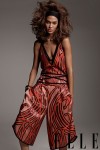

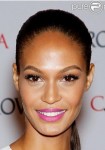
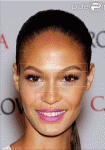
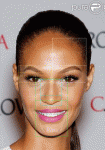
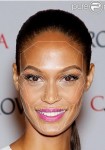
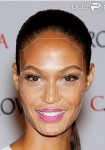





I just found one important solution by your post. I mean PhiMatrix. It is too essential for me…
Nice article on the beauty of beautiful face. Photo retouching specially beauty retouching plays a vital role in the present visual world. The image we see may be or may not be the same to the original one. Even the definition of beauty is being changed. Your post seems very interesting since it observes the sense of beauty from different perspectives. Thanks!
The reason the left side of her face is bigger is because her head is tilted at an angle in the pic that you used.
That could very well be the case. In the photo, her ears are not quite exactly equal in size, so that is likely the result of a slight turning of the head. Even so, the left side looks just slightly fuller. As you can see, it’s very difficult to find a perfect photo to use for facial analysis, but critical for its accuracy. See more on this in my article at https://www.goldennumber.net/facial-beauty-golden-ratio-photo-analysis/.
I just found one important solution by your post. I mean PhiMatrix. It is too essential for me
That could in all likelihood be the situation. In the photograph, her ears are not exactly precisely equivalent in size, so that is likely the aftereffect of a slight turning of the head. All things considered, the left side looks just marginally more full. As should be obvious, it’s hard to locate an ideal photograph to use for facial examination, yet basic for its precision.
Golden Ratio is a very useful common facial.
The reason the left side of her face is bigger is because her head is tilted at an angle in the pic that you used.
That is a valid observation. I often use the visibility of the ears on both sides of the face, looking for photos where the size of both ears is the same. This was the best photo I could find, but her face does have a slight turn the left side of the photo. Symmetry though, isn’t the key point of the analysis. It’s mostly about the golden ratio proportions and fit to the proportions of the beauty mask.
It is important to note that beauty is subjective and culturally constructed, and there is no universal standard for what constitutes beauty. Additionally, using a single mathematical formula to define beauty is a reductionist approach that ignores the complexity and diversity of human appearance.
That viewpoint isn’t supported by the evidence. Yes, there are certainly variations in beauty, and variations in different cultures and ethnicities. If you analyze the averages of human facial features though, you’ll find that they’re all based on the same golden ratio-based proportions, and this applies to any culture, ethnicity or era. This is what makes us look human, and the more a face deviates from these averages the more it will be perceived as being unattractive or disfigured. I cover this with examples on pages 166-179 of my book, “The Golden Ratio – The Divine Beauty of Mathematics” at https://bit.ly/goldenratiobook.
Incorrect, Sujan. Your post contains profoundly unwise and meretricious statements; it is mathematical relativism masquerading as common sense, despite being nothing of the sort. Yes, the subjective aspect can certainly override the objective when it comes to perceptions of beauty, and frequently does – but that is a different topic, related (amongst other things) to socio-cultural and psychological aspects if the human condition, and it absolutely does not mean that a purely aesthetically objective aspect of beauty does not exist in spite of this fact. Furthermore, the application of the ‘single mathematical formula’ you mention is not the crude, reductionist approach you seem to think it is. The manifestations of this seemingly simple formula are in fact immensely complex in practice when applied to a living, moving, three dimensional human being and the countless proportional relationships that exist within each and every body and face. If a purely objective analysis of aesthetics – one which discounts the impact of any external subjective factors to meet the conditions of a ‘fair test’ – is something that you do not consider to be of any interest or use, then perhaps you are on the wrong website!